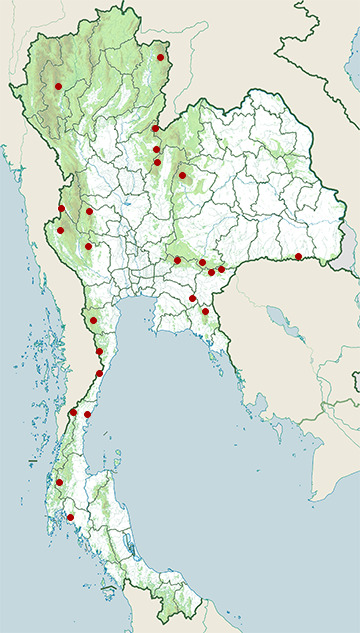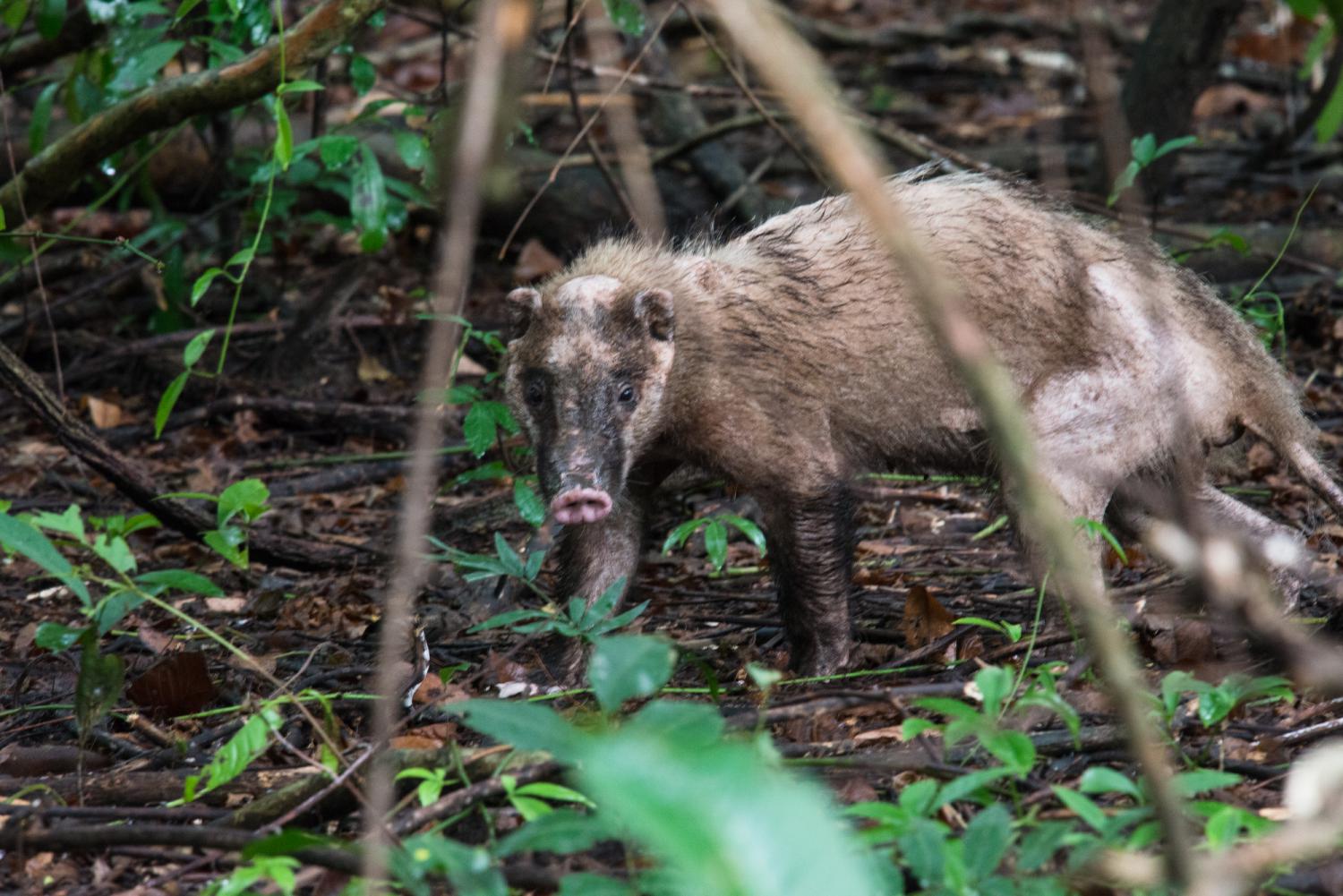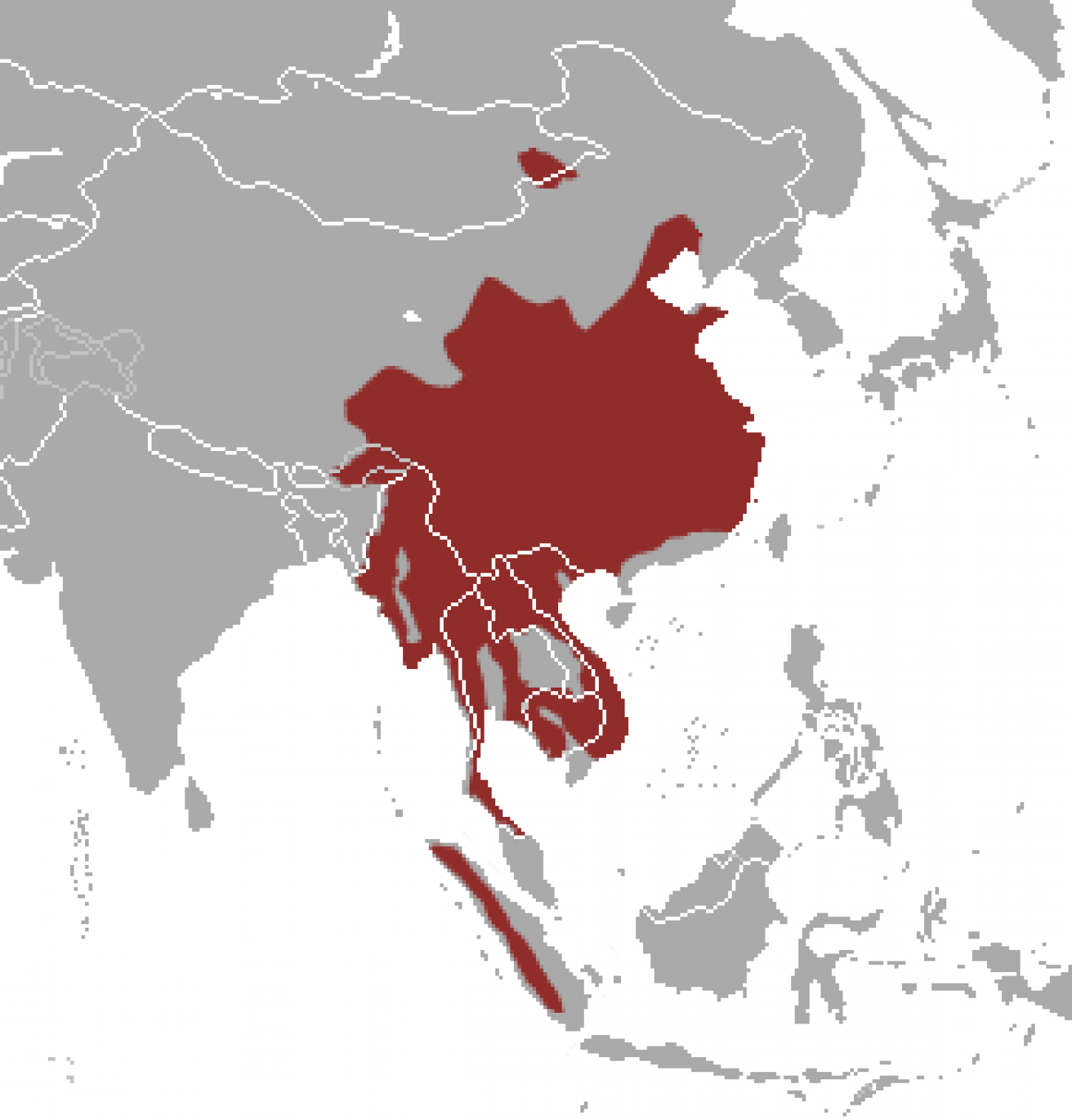Species of Thailand
Hog badger
Arctonyx collaris
Georges-Frédéric Cuvier, 1825
In Thai: หมูหริ่ง
The hog badger (Arctonyx collaris), also known as greater hog badger, is a terrestrial mustelid native to Central and Southeast Asia. It is listed as Vulnerable in the IUCN Red List of Threatened Species because the global population is thought to be declining due to high levels of poaching.
Characteristics
It has medium-length brown hair, stocky body, white throat, two black stripes on an elongated white face and a pink, pig-like snout. The head-and-body length is 55 - 70 cm, the tail measures 12 - 17 cm and the body weight is 7 - 14 kg. With weights regularly reported from 8.4 to 12 kg it is one of the world's largest terrestrial extant mustelids going on average body mass, perhaps behind only the wolverine and rivaling the European badger (although it is not known to rival the weights of the latter, better-known badger during autumn hypophagia).
Its appearance generally resembles the European badger, but it is generally smaller, with larger claws on the front feet. Its tail has long white hairs, and its front feet have white claws.
Distribution and habitat
Hog badger is considered fairly common in Thailand and in tropical evergreen forests and grasslands of the Terai in north-eastern India and eastern Bangladesh. It occurs in Indochina and in southern China. Its distribution in Myanmar is considered patchy. In the Indonesian island of Sumatra, hog badger occurs primarily above 2000 m with one record at 700 m. There is one isolated record in eastern Mongolia.
The IUCN considers the greater hog badger (A. collaris), the northern hog badger (A. albogularis) and the Sumatran hog badger (A. hoevenii) as three separate species. The greater hog badger is listed as a Vulnerable species. The other two are listed as Least Concern.
Ecology and behavior
The hog badger is active by day and not very wary of humans. Analysis of numerous camera trap pictures from Myanmar show no peak activity at either day or night.
The hog badger is omnivorous, its diet consists of fruits, roots and small animals.
This article uses material from Wikipedia released under the Creative Commons Attribution-Share-Alike Licence 3.0. Eventual photos shown in this page may or may not be from Wikipedia, please see the license details for photos in photo by-lines.
Scientific classification
- Kingdom
- Animalia
- Phylum
- Chordata
- Class
- Mammalia
- Order
- Carnivora
- Family
- Mustelidae
- Genus
- Arctonyx
- Species
- Arctonyx collaris
Common names
- German:
- Schweinsdachs
- Riesendachs
- English: Greater hog badger
- Spanish: Tejón porcino
- French:
- Blaireau à gorge blanche
- Blaireau-cochon
- Blaireau asiatique
- Italian: Tasso naso di porco
- Dutch: Varkensdas
- Russian: Свиной барсук
- Swedish: Svingrävling
- Thai: หมูหริ่ง
Subspecies
Arctonyx collaris albogularis, Edward Blyth, 1853
Common name: Northern hog badger
Range: Southern China northwards to Shensi
Arctonyx collaris collaris, Georges-Frédéric Cuvier, 1825
Common name: Greater hog badger
Range: Eastern Himalayas
Arctonyx collaris consul, Reginald Innes Pocock, 1940
Common name: Burmese hog badger
Range: Assam to Myanmar
Arctonyx collaris dictator, Oldfield Thomas, 1910
Common name: Indochinese hog badger
Range: Southern Thailand and Indochina
Arctonyx collaris hoevenii, Ambrosius Arnold Willem Hubrecht, 1891
Common name: Sumatran hog badger
Range: Sumatra
Arctonyx collaris leucolaemus, Henri Milne-Edwards, 1867
Common name: Chinese hog badger
Range: Northern China from South Kansu to Chihli
Synonyms
- Arctonyx annaeus, Michael Rogers Oldfield Thomas (1921)
- Arctonyx dictator, Michael Rogers Oldfield Thomas (1910)
Conservation status

Near Threatened (IUCN3.1)
Photos
Please help us review our species pages if wrong photos are used or any other details in the page is wrong. We can be reached via our contact us page.
Range Map

- Chaloem Rattanakosin National Park
- Doi Inthanon National Park
- Doi Phu Kha National Park
- Huai Kha Khaeng Wildlife Sanctuary
- Huai Yang Waterfall National Park
- Kaeng Krachan National Park
- Khao Ang Rue Nai Wildlife Sanctuary
- Khao Dinsor (Chumphon Raptor Center)
- Khao Kho District, Phetchabun
- Khao Laem National Park
- Khao Soi Dao Wildlife Sanctuary
- Khao Sok National Park
- Khao Yai National Park
- Kui Buri National Park
- Mueang Krabi District, Krabi
- Pang Sida National Park
- Phanom Dong Rak Wildlife Sanctuary
- Phu Hin Rong Kla National Park
- Phu Khiao Wildlife Sanctuary
- Phu Suan Sai National Park
- Sadeth Naikrom - Krom Luang Wildlife Sanctuary
- Ta Phraya National Park
- Thap Lan National Park
- Thung Yai Naresuan Wildlife Sanctuary


